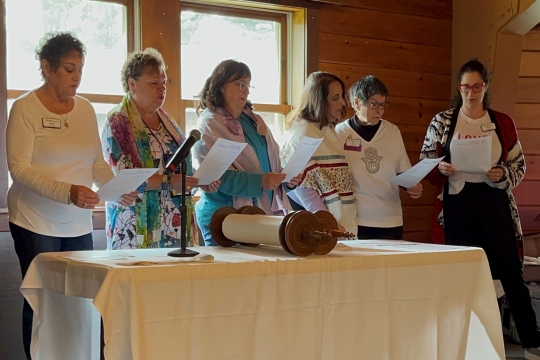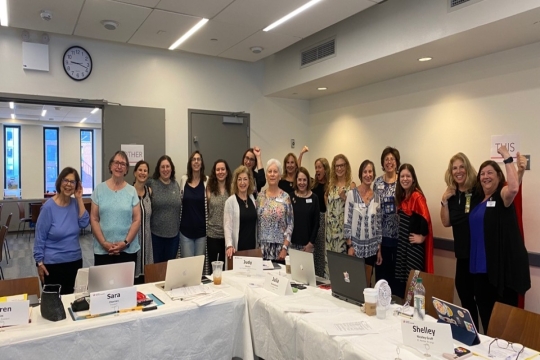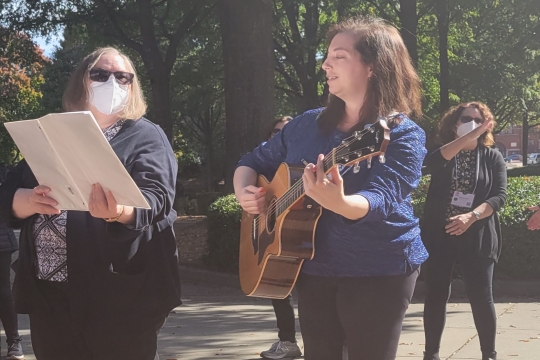by Ellen Bick
Earlier in Exodus, the Israelites are told that God expects them to be a “kingdom of priests and a holy nation.” And thus, in this Torah portion, Parashat T’tzaveh, God appoints Aaron and his sons as priests, and depicts the strong male-dominated society in which Aaron lived.
God describes the ornate and intricate priestly clothing and how it is to be made, and explains how to properly sanctify the priests. Aaron is also commanded to make incense offerings to God and to light the lamps every morning on an altar. God explains that once a year, Aaron will make an offering on that altar to atone for all of the Israelites' sins. Both the duties of the priests and their clothing had to be meticulous.
Despite the fact that women are not mentioned here, we know who was there helping to carry out these instructions. We know that women played a prominent role in the religious life of the household. We have read in other parts of the Torah about women who were experts in making textiles and performing tasks at the entrance of the meeting tent. Women carried out religious practices deemed necessary for “the well being and survival of their families.”
Although it does not say who made these textiles for Aaron and his sons, it was most likely women who were responsible, as they were the ones who produced the fabrics for the Tabernacle. And it was also likely that women prepared the oil used in the lighting of the lamp, the ner tamid.
Instead of viewing women as relegated to the sidelines, we can certainly see women as an important and integral part of society necessary to help Aaron and his sons carry out God’s instructions. So, too, today the women of our congregations through Women of Reform Judaism continue to play an important role in our Reform movement. Through the years, WRJ has identified new directions and goals, nurtured new leaders, and reached out to our own temple communities and the greater community. Our historic 100 years is evidence to that.
Often, when a need has been identified, WRJ has risen to the challenge and in so doing, has changed the course of history. One example is the strong and continuous support for clergy through the years. To this day, WRJ is the largest cumulative donor of scholarships to our rabbinical and cantorial students at all three North American Hebrew Union College-Jewish Institute of Religion campuses, and awards scholarships to overseas rabbinical students studying at Leo Baeck College in London, Abraham Geiger College in Berlin, and HUC-JIR in Jerusalem.
Then there was the historic decision to build the dormitory for rabbinical students in Cincinnati in 1925, which is still called the Sisterhood Dorm today. And attendees at the 2007 Assembly in San Diego saw the emotional donation of a torah to College Rector Rabbi Dr. Walter Homolka, himself a WRJ scholarship recipient, for the Abraham Geiger College in Berlin. Additionally, YES Funds were donated to establish the WRJ Music Library at the School of Cantorial Arts at Abraham Geiger College.
Another important example of WRJ's involvement was its creation of NFTY, the Reform Movement youth movement, in 1937. NFTY remains a vital organization in the Movement and WRJ has continued to underline its support and involvement through continuous donations to NFTY and to the Youth Engagement program.
At the recent 2013 WRJ Assemby in San Diego, Rabbi David Ellenson gave a heart warming speech about WRJ’s crucial involvement and funding for HUC-JIR through the years, funding that has sometimes been essential to keeping their doors open.
On a local level, our synagogue-based sisterhoods are a support and partner for our congregations. I continually hear from sisterhoods who are donating monies to fund new prayer books, new kitchens, new programming, and camp scholarships for our kids.
I see sisterhood women receive excellent leadership training through their Districts and WRJ with some continuing on to become their temple presidents. There are so many ways that our sisterhoods are intertwined with the health and ongoing sustenance of our congregations. That collaborative, supportive, continuing relationship with our synagogues will benefit us all and make us stronger for the effort.
Ellen Bick is WRJ Pacific District President and a member of Congregation Beth Israel Sisterhood in Portland, OR.
Related Posts
Image

Parashat Yom Rishon shel Rosh HaShanah
September 14, 2023
During the High Holidays, my thoughts turn to the special blessings, prayers, and melodies that shape our journey from Selichot to Rosh HaShanah to the final shofar blast on Yom Kippur. Many of our prayers in the High Holiday liturgy are written in the plural.
Image

Cultivating a Culture of Accountability and Belonging
September 8, 2023
And, we’re off! Many of us have worked over the summer with friends and colleagues to set the calendar for the year ahead, including meetings, events, and other opportunities for gathering.
Image

My Journey from Altar-Girl to Cantorial Soloist
August 11, 2023
I was born a Goldman, and always knew I was Jewish on my dad’s side. Although my whole family was spiritual in their own way, the Jewish side of my family didn’t have warm feelings towards religion, and the only thing passed down to me was the Jewish humor I grew up in New Jersey and had an open...
